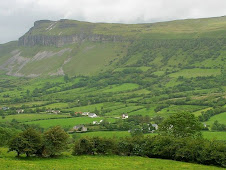Nine days after the Gweedore area on the Atlantic coast of Co. Donegal (in the far North-West of Ireland) was hit by downpours of heavy rain and subsequently affected by severe flooding (see my entries of June 23rd & 24th), similar weather conditions have occurred on a much larger scale in several parts of the island.
In the early hours of this morning - especially in the three hours between about 2 am and 5 am - a series of sudden thunderstorms with torrential downpours of rain hit areas in the South and East, as well as parts of the Midlands. But the most severely affected area today was Dublin.
 Massive rainfall of up to 40 mm per hour overwhelmed the drainage system in the capital and caused severe flooding on the north-side of the city, in particular in Howth, Malahide, Drumcondra, Glasnevin (left), Clontarf and Donnycarney.
Massive rainfall of up to 40 mm per hour overwhelmed the drainage system in the capital and caused severe flooding on the north-side of the city, in particular in Howth, Malahide, Drumcondra, Glasnevin (left), Clontarf and Donnycarney.
By about 5 am many areas of Dublin were affected by the floods, which caused the early morning traffic to be seriously disrupted and come to a complete standstill on some main roads. Motorists described the worst hit areas in the Dublin area as "akin to swimming pools".
According to Gardaí the southbound slip road at the junction of the M 1/M 50 interchange in the North of Dublin is affected, as are Newlands Cross on the N 7 and Rathcoole.
The M 1 at the entrance to the Dublin Port Tunnel is "barely passable on one lane only". The other three lanes are impassable. People have also been asked to avoid the coast road in particular.
The N 11, which was closed this morning from Booterstown Avenue to Fosters Avenue, has now reopened. There are however still problems southbound at the Loughlinstown Roundabout.
 Flooding was also reported from the areas of Collins Avenue, Richmond Road, Sherrard Street, Clanmoyle Road (right) and many other districts of Dublin's inner city.
Flooding was also reported from the areas of Collins Avenue, Richmond Road, Sherrard Street, Clanmoyle Road (right) and many other districts of Dublin's inner city.
The Dublin Fire Brigade has appealed to people not to travel this morning, unless absolutely necessary. In particular it is asking people not to drive into areas where roads are flooded, as there is a real risk they will become stranded.
As I write this, many roads in and around Dublin are still affected by flooding, and some DART (Dublins city railway) services are also not operating because of water on the tracks.
According to Met Éireann (the national meteorological office) more than two weeks' of average rainfall was recorded this morning at Dublin Airport in just one hour.
However, the airport remains open and a spokesperson said that flights were not affected. But passengers are advised to give themselves extra time getting to the airport because of flooding on some of the approach roads.
In the North of Dublin's inner city the greatest damage reported so far was caused in Sherrard Street, where 20 people had to be evacuated from their apartments by members of the Civil Defence Force at around 4 am.
 Serious damage has also been reported from the Mater Hospital (left), which is one of Dublin's largest medical facilities. Their Accident & Emergency department has been flooded and remains closed.
Serious damage has also been reported from the Mater Hospital (left), which is one of Dublin's largest medical facilities. Their Accident & Emergency department has been flooded and remains closed.
A flat roof in the old part of the hospital has also collapsed, and a number of patients had to be moved from one of the wards.
In announcements on RTÉ Radio and local radio stations people have been asked not to come to the hospital for acute treatment in the A&E sector for the time being.
A hospital spokeswoman advised that people with outpatient appointments today could attend as normal, while those scheduled to have elective surgery should contact the hospital before leaving their home to check if their appointment has been affected.
The Fire Brigade was also called to a residential house in Monkstown, Co. Dublin, where the roof has collapsed.
Iarnród Éireann (the Irish railways) announced that all their services are "running as normal again", after they were earlier experiencing disruption due to flooding.
In particular, flooding at Dún Laoghaire had disrupted rail services on the line between Dalkey and Dún Laoghaire.
However, the railway station at Bayside is still closed due to flooding and no DART trains are stopping there. Passengers are being asked to use the Sutton or Howth Junction stations as an alternative. Dublin Bus says it is accepting rail tickets in the area.
This morning a spokesman for Dublin City Council has said that "potentially any house in the capital could have been flooded overnight". This statement has surprised and alarmed many citizens who wonder how safe it actually is to live in Dublin.
City Council emergency staff and members of the Civil Defence Force had been on standby since a weather warning was issued by Met Éireann at 9 pm las night. They went out once rain began to fall at 2 am, but the severe force of the weather soon overwhelmed all attempts of organised damage limitation.
Meanwhile people have criticised Dublin City Council for negligance and for not maintaining the drainage and sewerage system properly. Only in August of last year Dublin experienced a spell of similar bad weather, which caused widespread flooding in some areas. Afterwards City Council officials promised to improve the drainage system and work on better protective measures. But residents affected by today's floods say that "nothing has been done" and that many properties are in serious danger. Apart from August 2008, the last time Dublin was hit by weather of this severity was thirteen years ago.
Here in the South-East we also experienced torrential rain, but it was by far not as severe as in Dublin.
I woke up shortly after 3 am from the noise of loud thunder and heavy rain falling onto the roof of my house with amazing speed. It sounded almost like a massive crescendo created by a band of wild drummers. When I got up and looked out of the window, I saw rainfall of a severity we have not experienced here in many years. It appeared as if someone was standing on the roof, emptying barrels of water without pause.
However, there have been so far no reports of flooding or damage in our area, and I am happy to say that at present the rain has stopped here.
But the flood peril might not be over yet. According to Met Éireann the current weather system coming into Ireland from across the Atlantic is still "a massive low front" and more heavy rain is expected over the coming days.
Gerald Fleming, chief meteorologist at Met Éireann, said the warm and humid weather we experienced over the past two weeks was the main cause for this morning's thunderstorms. And there could well be more to come, together with torrential rainfall.
Somehow this all reminds me of last year's washed-out 'summer', and I can only hope that after the low front has passed over us eventually, some warmer weather with sunshine will come back to Ireland. It is bad enough to be in a deep economic recession and ruled by a totally incomptent government. But when the weather is turning against us as well, it is almost too much to bear.
The Emerald Islander
In the early hours of this morning - especially in the three hours between about 2 am and 5 am - a series of sudden thunderstorms with torrential downpours of rain hit areas in the South and East, as well as parts of the Midlands. But the most severely affected area today was Dublin.
 Massive rainfall of up to 40 mm per hour overwhelmed the drainage system in the capital and caused severe flooding on the north-side of the city, in particular in Howth, Malahide, Drumcondra, Glasnevin (left), Clontarf and Donnycarney.
Massive rainfall of up to 40 mm per hour overwhelmed the drainage system in the capital and caused severe flooding on the north-side of the city, in particular in Howth, Malahide, Drumcondra, Glasnevin (left), Clontarf and Donnycarney.By about 5 am many areas of Dublin were affected by the floods, which caused the early morning traffic to be seriously disrupted and come to a complete standstill on some main roads. Motorists described the worst hit areas in the Dublin area as "akin to swimming pools".
According to Gardaí the southbound slip road at the junction of the M 1/M 50 interchange in the North of Dublin is affected, as are Newlands Cross on the N 7 and Rathcoole.
The M 1 at the entrance to the Dublin Port Tunnel is "barely passable on one lane only". The other three lanes are impassable. People have also been asked to avoid the coast road in particular.
The N 11, which was closed this morning from Booterstown Avenue to Fosters Avenue, has now reopened. There are however still problems southbound at the Loughlinstown Roundabout.
 Flooding was also reported from the areas of Collins Avenue, Richmond Road, Sherrard Street, Clanmoyle Road (right) and many other districts of Dublin's inner city.
Flooding was also reported from the areas of Collins Avenue, Richmond Road, Sherrard Street, Clanmoyle Road (right) and many other districts of Dublin's inner city.The Dublin Fire Brigade has appealed to people not to travel this morning, unless absolutely necessary. In particular it is asking people not to drive into areas where roads are flooded, as there is a real risk they will become stranded.
As I write this, many roads in and around Dublin are still affected by flooding, and some DART (Dublins city railway) services are also not operating because of water on the tracks.
According to Met Éireann (the national meteorological office) more than two weeks' of average rainfall was recorded this morning at Dublin Airport in just one hour.
However, the airport remains open and a spokesperson said that flights were not affected. But passengers are advised to give themselves extra time getting to the airport because of flooding on some of the approach roads.
In the North of Dublin's inner city the greatest damage reported so far was caused in Sherrard Street, where 20 people had to be evacuated from their apartments by members of the Civil Defence Force at around 4 am.
 Serious damage has also been reported from the Mater Hospital (left), which is one of Dublin's largest medical facilities. Their Accident & Emergency department has been flooded and remains closed.
Serious damage has also been reported from the Mater Hospital (left), which is one of Dublin's largest medical facilities. Their Accident & Emergency department has been flooded and remains closed.A flat roof in the old part of the hospital has also collapsed, and a number of patients had to be moved from one of the wards.
In announcements on RTÉ Radio and local radio stations people have been asked not to come to the hospital for acute treatment in the A&E sector for the time being.
A hospital spokeswoman advised that people with outpatient appointments today could attend as normal, while those scheduled to have elective surgery should contact the hospital before leaving their home to check if their appointment has been affected.
The Fire Brigade was also called to a residential house in Monkstown, Co. Dublin, where the roof has collapsed.
Iarnród Éireann (the Irish railways) announced that all their services are "running as normal again", after they were earlier experiencing disruption due to flooding.
In particular, flooding at Dún Laoghaire had disrupted rail services on the line between Dalkey and Dún Laoghaire.
However, the railway station at Bayside is still closed due to flooding and no DART trains are stopping there. Passengers are being asked to use the Sutton or Howth Junction stations as an alternative. Dublin Bus says it is accepting rail tickets in the area.
This morning a spokesman for Dublin City Council has said that "potentially any house in the capital could have been flooded overnight". This statement has surprised and alarmed many citizens who wonder how safe it actually is to live in Dublin.
City Council emergency staff and members of the Civil Defence Force had been on standby since a weather warning was issued by Met Éireann at 9 pm las night. They went out once rain began to fall at 2 am, but the severe force of the weather soon overwhelmed all attempts of organised damage limitation.
Meanwhile people have criticised Dublin City Council for negligance and for not maintaining the drainage and sewerage system properly. Only in August of last year Dublin experienced a spell of similar bad weather, which caused widespread flooding in some areas. Afterwards City Council officials promised to improve the drainage system and work on better protective measures. But residents affected by today's floods say that "nothing has been done" and that many properties are in serious danger. Apart from August 2008, the last time Dublin was hit by weather of this severity was thirteen years ago.
Here in the South-East we also experienced torrential rain, but it was by far not as severe as in Dublin.
I woke up shortly after 3 am from the noise of loud thunder and heavy rain falling onto the roof of my house with amazing speed. It sounded almost like a massive crescendo created by a band of wild drummers. When I got up and looked out of the window, I saw rainfall of a severity we have not experienced here in many years. It appeared as if someone was standing on the roof, emptying barrels of water without pause.
However, there have been so far no reports of flooding or damage in our area, and I am happy to say that at present the rain has stopped here.
But the flood peril might not be over yet. According to Met Éireann the current weather system coming into Ireland from across the Atlantic is still "a massive low front" and more heavy rain is expected over the coming days.
Gerald Fleming, chief meteorologist at Met Éireann, said the warm and humid weather we experienced over the past two weeks was the main cause for this morning's thunderstorms. And there could well be more to come, together with torrential rainfall.
Somehow this all reminds me of last year's washed-out 'summer', and I can only hope that after the low front has passed over us eventually, some warmer weather with sunshine will come back to Ireland. It is bad enough to be in a deep economic recession and ruled by a totally incomptent government. But when the weather is turning against us as well, it is almost too much to bear.
The Emerald Islander







































No comments:
Post a Comment